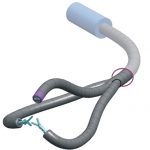The GIFT-Surg Project

UCL is working towards a major development in surgery on unborn babies thanks to a £10 million award from the Wellcome Trust and the Engineering and Physical Sciences Research Council (EPSRC), under the ‘Innovative Engineering for Health’ initiative.
This new research project, titled GIFT-Surg (Guided Instrumentation for Fetal Therapy and Surgery), is led by UCL in collaboration with KU Leuven in Belgium, who will work with surgeons and doctors at Great Ormond Street Hospital, University College London Hospital NHS Trust and UZ Leuven as part of a highly multidisciplinary team.
GIFT-Surg will engineer a novel combination of innovative interventional imaging systems and MRI/ultrasound scans to provide extremely accurate visualisation, both pre-operative and real-time, which will be used by the surgeon in conjunction with advanced surgical tools that offer new levels of flexibility and precision. A training platform will also be developed to equip surgeons with the necessary skills in the treatment of congenital birth defects such as spina bifida and twin-to-twin transfusion syndrome.
Performing surgery on fetuses whilst still in the womb is a risky business. Although pioneering work in this field began in the 1980s, it remains very challenging, with only a few highly trained teams around the world treating a handful of conditions. Our aim with GIFT-Surg is to create breakthrough transformations and improvements in the treatment of congenital problems in the womb.
 We’re working to develop an extended flexible mechatronic multi-finger device that will be fed in through a small incision, of approximately 4mm, in the abdomen of the mother. This device will enable surgeons to operate and perform complex procedures from outside the womb. The three “fingers” of the device will offer the surgeon superior dexterity and better vision at the surgery site. While two of the fingers can carry out delicate procedures, in the case of spina bifida, patching up the source of the protrusion from the spine, the third will carry an innovative endoscopic imaging system that will create 3D images of the environment inside womb and acquire tissue properties making it possible to identify anatomic structures on and below the tissue surfaces. The surgeon will have direct and real-time access to these images and guidance cues which will be clearly displayed on a screen visible to them in the operating theatre. The images will also serve as a feedback for guiding the dexterous instrumentised arms.
We’re working to develop an extended flexible mechatronic multi-finger device that will be fed in through a small incision, of approximately 4mm, in the abdomen of the mother. This device will enable surgeons to operate and perform complex procedures from outside the womb. The three “fingers” of the device will offer the surgeon superior dexterity and better vision at the surgery site. While two of the fingers can carry out delicate procedures, in the case of spina bifida, patching up the source of the protrusion from the spine, the third will carry an innovative endoscopic imaging system that will create 3D images of the environment inside womb and acquire tissue properties making it possible to identify anatomic structures on and below the tissue surfaces. The surgeon will have direct and real-time access to these images and guidance cues which will be clearly displayed on a screen visible to them in the operating theatre. The images will also serve as a feedback for guiding the dexterous instrumentised arms.
 By passing tools through a small incision, surgeons minimise the risks of complications for the mother and fetus, notably preterm labour. There already exists some fetal surgery which takes advantage of this. Minimal access with laser coagulation, for example, is the current standard of care for treating twin-to-twin transfusion syndrome (TTTS) a condition where two identical twins share blood through the same placenta. While the donor twin is deprived of blood and can develop growth defects, the other twin is given too much blood and can suffer from heart failure. To correct this, surgeons currently operate using a fetoscope with a laser coagulator attached to it. This cauterises the blood vessels that link the blood circulation between the twins. Although this is a working solution, the existing tools lack flexibility and therefore, this kind of surgery is still quite complex and has limited possibilities when twins, triplets and the placenta are arranged in certain configurations.
By passing tools through a small incision, surgeons minimise the risks of complications for the mother and fetus, notably preterm labour. There already exists some fetal surgery which takes advantage of this. Minimal access with laser coagulation, for example, is the current standard of care for treating twin-to-twin transfusion syndrome (TTTS) a condition where two identical twins share blood through the same placenta. While the donor twin is deprived of blood and can develop growth defects, the other twin is given too much blood and can suffer from heart failure. To correct this, surgeons currently operate using a fetoscope with a laser coagulator attached to it. This cauterises the blood vessels that link the blood circulation between the twins. Although this is a working solution, the existing tools lack flexibility and therefore, this kind of surgery is still quite complex and has limited possibilities when twins, triplets and the placenta are arranged in certain configurations.
Minimally invasive surgery can also be currently used to stimulate lung growth in another condition called congenital diaphragmatic hernia. However a subsequent more invasive procedure called ex utero intrapartum treatment procedure, or “EXIT surgery”, might then be required at the time of the baby’s delivery. Even for spina bifida, minimally invasive repair is possible in a few cases but, it remains inaccurate, has a high failure rate and requires multiple small incisions, which increases the risks associated with the procedure. Although spina bifida is one of the most common birth defects, it also requires one of the most complex procedures for treatment.
